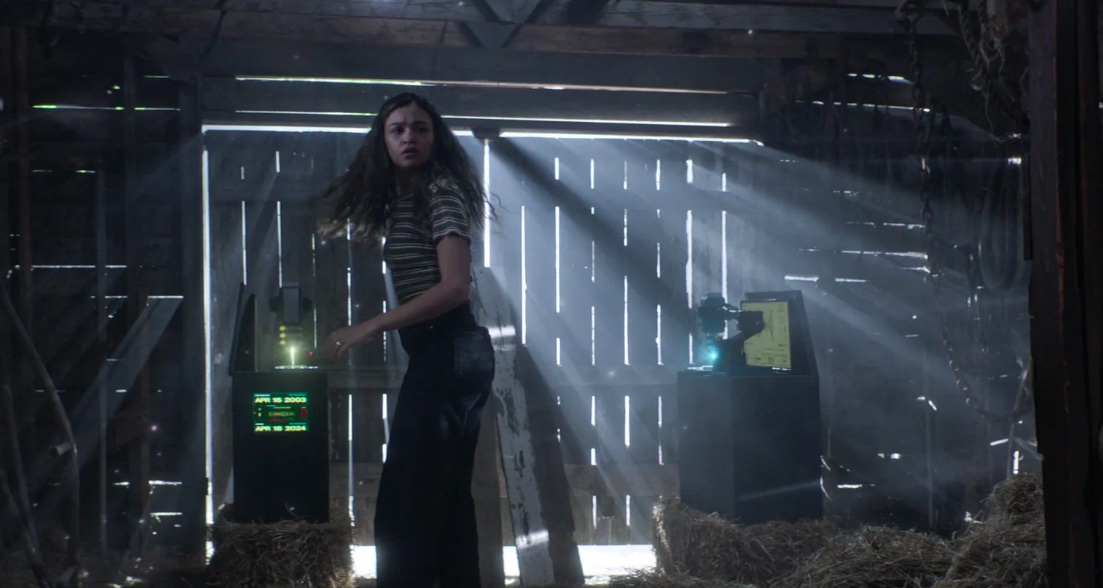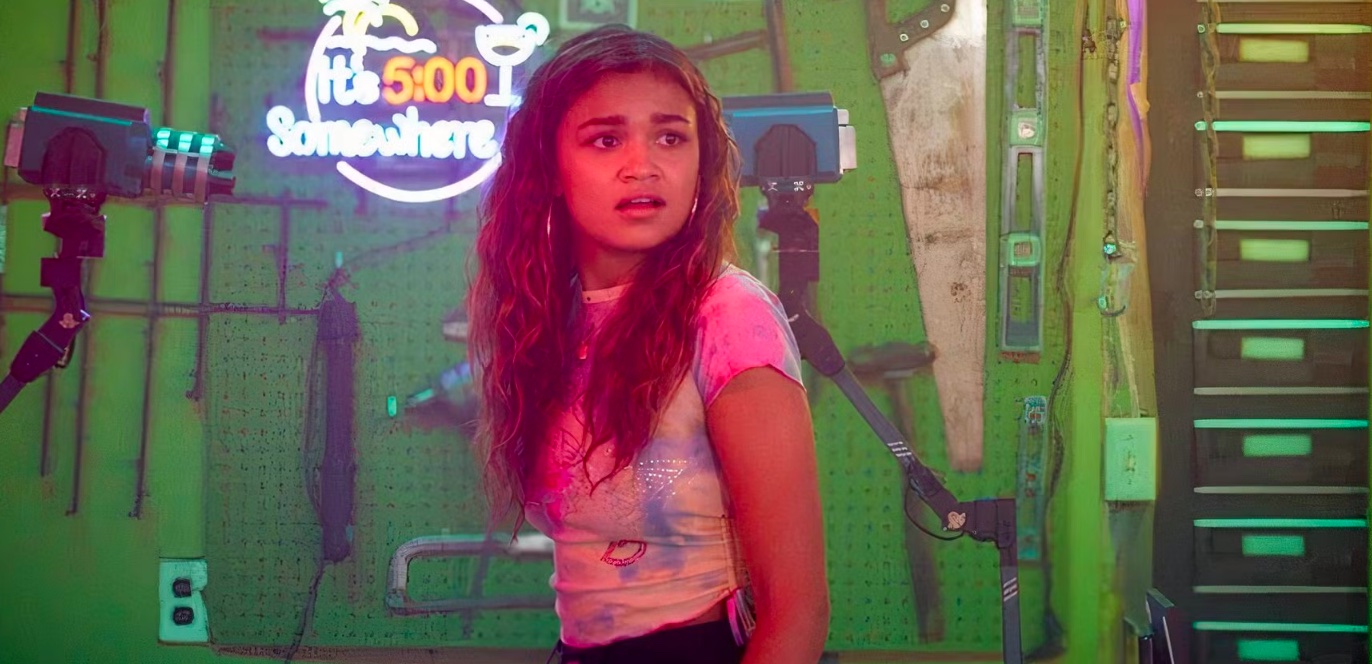Netflix’s ‘Time Cut’ presents the story of a girl who travels back in time to save her sister from being killed by a serial killer. The protagonist is a girl named Lucy who feels suffocated by her parents, who are still grieving their first daughter, who was killed twenty years ago. The killer was never caught, and the parents are so worried about Lucy’s safety that they refuse to let her live her life as she wants to. One day, by some stroke of luck, Lucy stumbles upon a time machine and ends up twenty years in the past when her sister is still alive. The following series of events changes everything about Lucy’s life and the people around her permanently. SPOILERS AHEAD
The Laws of Time Travel in Time Cut
Where there is time travel, there must be a time machine, and Lucy finds one in the barn where her sister was murdered. She later discovers that the machine was made by a serial killer who wanted to commit the perfect crime. Instead of killing people in the concurrent time, he waited for the future, created the time machine, and then traveled to the past to kill the people he hated. The time machine was created using the tech from SONR, the local spacetime research organization, which contained rubidium used to power the time machine, which would create an explosion through the collision of matter and anti-matter. The quantum entanglement of the two would create a wormhole that would allow a person to travel back and forth in time.

The killer planned to use the time machine, and once the job was done, he would go back to the future, leaving no way for anyone to catch him. This worked the first time around, but then Lucy entered the past, and everything changed. When Lucy lands in the past, her first concern is to find a way back home. Her second concern is to prevent the murders from happening, but she is told that tinkering with the past may lead to the creation of paradoxes, which can completely rewrite things. For starters, if Lucy saves her sister, Summer, it would keep her parents from attempting to have another child, which means that Lucy will never be born, which creates a whole different loop of its own. Despite the warning, Lucy tries to stop the first two of the four killings, but the attempt ends with one more person’s death, which did not happen in the original timeline.
It’s clear to Lucy now that every second she spends in the past can have severe repercussions on the future, but that doesn’t solve her moral dilemma. Eventually, she decides to save the people, not caring if this would erase her from existence. However, she later discovers that time travel works a bit differently than she had expected. By changing the past, she creates a future where her parents never have her, but that doesn’t erase her from existence. The Lucy from the original timeline still exists, just as the serial killer would continue to exist, even if his past self killed himself. She would remain a paradox, sticking out like a sore thumb in the fabric of the spacetime continuum, belonging neither to the past nor the future.
The Chronology of Events in the Original Timeline

By the end of ‘Time Cut,’ two timelines are formed which result in very different futures for the people involved in it. Here’s what happens in the original timeline. On April 16, 2003, the serial killer murders two teens in a mall. The next day, he kills Emmy, and on April 18, Lucy’s sister Summer is killed. The reason that the killer, revealed to be Quinn, goes back to April 16 is because this is the date when he was utterly humiliated when his classmates threw him into the river, even when they knew that he couldn’t swim. While Quinn tried to save himself, everyone in the crowd laughed, while no one came to his rescue.
As if this wasn’t humiliating enough, Quinn professed his love to Summer on the night of April 18 during the spring fling party, but she told him that she could never love him the same way. Quinn took this rejection to heart, not knowing that Summer was referring to her being gay. In any case, even if she were straight, it didn’t give him license to Quinn to murder her just because she rejected him. Anyway, Quinn didn’t murder all those people straight away. While he seethed with shame and fear, things got worse for him. As years passed by, Quinn worked on a time machine, singularly focused on getting revenge on the people who had made him feel small all those years ago. He discovered that he needed rubidium to power his machine, so he broke into SONR, killed a guard, stole the rubidium, fired his time machine, and went back to April 16, 2003, to start the killings.
Summer is killed on April 18, 2003, which leaves her parents heartbroken. Because they were happy with the child they had, they’d never thought about having another child. But then, when Summer was killed, they had to reconsider their decision. After several rounds of IVF, they finally had Lucy. Due to the loss of Summer, they became overly protective of Lucy, forcing her to forever live in the shadow of the dead sister she never knew. On the 20th anniversary of Summer’s death, Lucy visits the memorial, but this is also the day when Future Quinn decides to go back in time, completely unaware that Lucy has followed him.
The Rewritten Series of Events in the New Timeline

Lucy was never supposed to follow Future Quinn to 2003, but she did, and that changed everything. Because Lucy knows about all the deaths, she can also come up with ways to save the victims, which alters the timeline completely. Due to her interference, the third victim is a security guard who dies while trying to stop the killer. This is the first major change in the timeline. The second change comes when Lucy, Quinn, and Summer save Emmy from dying. This brings a huge change in Summer’s life because almost losing the girl she loves makes her come out of the closet, something she had put on hold, which caused a rift between her and Emmy.
The second major change is when Lucy saves Summer. Knowing exactly where the killer is going to find Summer, a plan is hatched to trap and kill the serial killer and prevent any further murders from happening. There is a minor hitch, but the plan works after all. Lucy uses the machine to take her and the killer back to the 2024 timeline, where she kills him, ending the cycle of death once and for all. But having saved her sister, she has made some serious changes in her own life. Now that Summer is alive, her parents don’t need to think about another kid, so they never do the IVF rounds, and Lucy is never born in this new timeline. Still, the original Lucy remains, the reminder of the paradox that she herself created.

When Lucy realizes that her parents are not her parents anymore, she feels entirely tether-less in the 2024 timeline. However, just because the future has forgotten her doesn’t mean she has been erased from the past, which is where she felt like she belonged for the first time. So, she decides to go back to the 2003 timeline. Here, things have changed radically. Summer is now with Emmy and holds the promise of living the long and fulfilling life she should have originally. Lucy starts living with her, getting to be with the loving parents she deserved in her original timeline. She applies for NASA internship and gets it in 2003, securing her future.
The most important change in this timeline happens to Quinn. Lucy’s arrival stops him from being thrown into the river and being humiliated in front of the whole school. Because she and Lucy are outcasts, they connect with each other, which gives Quinn the sense of camaraderie he’d never found in his original timeline. Seeing himself turn into a killer opens Quinn’s eyes, and he promises himself that he will never become the kind of person who kills someone just because he is rejected. This means that he will never turn into a serial killer, which means that no new time-traveling serial killers will come knocking in 2003 Sweetly anymore.
Read More: Netflix’s Time Cut: All Filming Locations Explored


You must be logged in to post a comment.